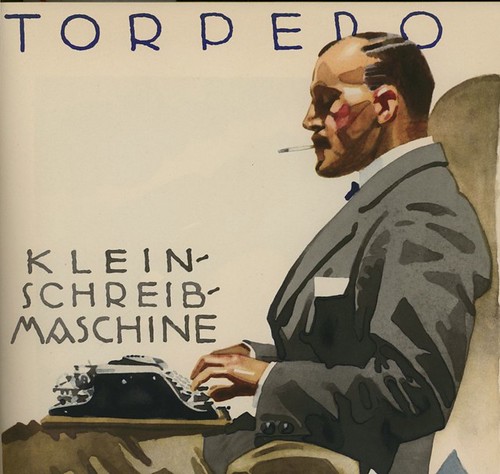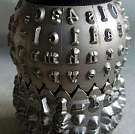 1 2 Jump to
1 2 Jump to
- beak
- Key Master
 Offline
Offline 
- From: Qld Australia
- Registered: 24-3-2013
- Posts: 929
Replacing a broken draw-band on a Remington Junior (1930s) portable.
The carriage of such a machine, new to me, suddenly stopped moving mid-session. A quick look at the back showed a piece of frayed string sticking out – ah! Draw-band broken. Which is hardly surprising, given that this cord has been taking the strain for about seventy years.
A few minutes on the web gave me the principles, and although it looked fiddly, it seemed as though I could do it. I also found that many recommended not fibre cord as a replacement, but strong fishing line (50lb + monofilament) which I had to hand. A scrap of such can be had from any fishing shop.
Now, I am far from even the shadow of an expert on typewriter repairs, but the task was done in half-an hour, and without pain, so I thought I would share what I discovered in doing it.
Tools I found helpful:
Tweezers good enough to grab and hold on to fishing line.
Screwdrivers that really do fit any screws which need to be undone, such as the one that secures the end of the draw-band to the carriage.
A narrow bar or rod of some kind that can be inserted into the spring drum to stop it turning temporarily after it has tensioned.
Knife or scissors.
Piece of stiff, thin wire several inches longer than the width of the typewriter. Bend a small eye in one end.
Good lighting and a small torch – you need to see clearly into the guts of the mechanism.
Right and left as mentioned below are as seen from the front; as when typing.
I cut a piece of fishing line twice the width of the typewriter – you want plenty of spare when working with monofilament – it’s hard to hold and knot when there is insufficient length to grasp properly. All knots require far more turns than when using fibre; four or five at least.
I began by tying the monofilament to the hole in the drum where the old cord emerged – actually, I tied it to the very end of the old cord itself – not being game to take the drum apart and attach it directly to the spring, as most sites seem to recommend. I tied a single knot in the old cord as close to the drum as I could, and tied the monofilament behind that.
Then I took several turns on the spring drum to tension it up – how many tensioning turns to take was a problem; I obviously took less than I might have, because the end result did not have the same degree of tension on the carriage as before, but it had sufficient. As long as the carriage will make it all the way to the left, and firmly, when you hit the space bar, all is well, I guess, and the lesser tension also reduced the overall amount of noise that the machine makes.
Having tensioned the drum, you have to prevent it from unwinding itself while you fix the other end of the draw-band. I simply inserted a very thin screwdriver through the hole in the drum, being very careful not to disturb the spring itself. I gently let the drum unwind a little until the screwdriver fouled some part of the frame, so halting the drum.
Now you have to identify the path that the band must take through the back of the mechanism in order to reach that place on the right hand end of the carriage where it is secured by a screw or clamp. This path is dead straight, and can be traced easily by using the stiff wire, inserting it from right to left through the machine, aiming from the securing screw to the diverter at the other end. Near the drum, and above it, is a diverting sheave (little pulley wheel) which turns the path of the band through 90 degrees and on to the drum. Just before this is a little fairlead – a guide for the band - so don’t miss this out; the line must go through it. It was simplicity itself to draw the line from left to right by withdrawing the wire (it had a little hook at the end) all the way through to the securing nut. Get the line threaded as far as the fairlead before using the wire.
Make sure that the monofilament has no kinks and is not tangled round any bit of mechanism. Ensure that the carriage is all the way to the right, and secure the line, which I did by taking three turns round the slightly loosened screw, and then tigh
tening it, and do note that the line should go round the screw in the same direction as tightening the screw; this way the action of doing up the screw makes the line tighter, but if you wind the line the other way doing up the screw tends to throw the line off the screw. Now gently release the drum and test. If all’s well, trim off any excess line. Job done.
I used a plump cushion to rest the machine on when turning it over; there are many levers sticking out of this machine, and one should be careful not to bend any of them on a hard surface.
If anyone would like explanatory photos, please ask and I will post some when I have more time.
Any comments or suggested improvements welcomed. Pictures added at post 6.
ETA
is the machine in question.
Last edited by beak (24-4-2013 03:29:59)
Sincerely,
beak.
- Shangas
- Speed Champion
 Offline
Offline - From: Melbourne, Australia
- Registered: 17-3-2013
- Posts: 298
Re: Replacing a broken draw-band on a Remington Junior (1930s) portable.
I honestly live in fear of a drawband malfunction. I've spoken to many people online who say it's a relatively easy (albeit, fiddly) repair. As yet, I've not had an occasion to carry out such a repair myself.
However, should I need to do so, I shall refer to this posting.
I've read on numerous websites that another suitable alternative for a drawband is a shoelace! There is certainly a strong resemblance between the two materials. And shoelaces are used to repeated tugging and pulling, so I suppose it makes sense.
Oh yeah, before I forget...
PHOTOGRAPHS PLEASE! *begz*
Last edited by Shangas (23-4-2013 06:35:38)
"Not Yet Published" - My History Blog
"I just sit at a typewriter and curse a bit" - Sir Pelham Grenville "P.G." Wodehouse
"The biggest obstacle to professional writing is the necessity for changing a typewriter ribbon" - Robert Benchley
- beak
- Key Master
 Offline
Offline 
- From: Qld Australia
- Registered: 24-3-2013
- Posts: 929
Re: Replacing a broken draw-band on a Remington Junior (1930s) portable.
Yes, I too read about the shoe-string, but they seem much ticker than the cord I removed, so I went for the fishing line.
The only tricky thing (I think) is the drum tensioning; if you damage the drum, you're in for a more difficult repair, and a broken spring may be difficult to replace. So I suggest taking great care with the drum and the spring - don't stress either, take your time and find ways of handling the drum which are likely to cause it the minimum of trauma!
Shall take pix and post later on.
Last edited by beak (23-4-2013 06:41:52)
Sincerely,
beak.
- •
- Stevetype33
- Touch Typist
 Offline
Offline 
- From: UK
- Registered: 16-3-2013
- Posts: 172
Re: Replacing a broken draw-band on a Remington Junior (1930s) portable.
Thanks for your detailed explanation, Beak. It's very useful.
I've seen a few nice typers that have gone cheap because of carriage problems (from the description, broken cords) so it's good to know that the repair is relatively straightforward.
How did you guage the right tension on the spring? Is there a rule-of-thumb?
- Shangas
- Speed Champion
 Offline
Offline - From: Melbourne, Australia
- Registered: 17-3-2013
- Posts: 298
Re: Replacing a broken draw-band on a Remington Junior (1930s) portable.
I thought the way you judged drum-tension was simply to wind it up enough times that the carriage-strap goes around it in its entirety. That way it's always at the right tension when the machine's in use. I think I saw it in YouTube video somewhere.
"Not Yet Published" - My History Blog
"I just sit at a typewriter and curse a bit" - Sir Pelham Grenville "P.G." Wodehouse
"The biggest obstacle to professional writing is the necessity for changing a typewriter ribbon" - Robert Benchley
- beak
- Key Master
 Offline
Offline 
- From: Qld Australia
- Registered: 24-3-2013
- Posts: 929
Re: Replacing a broken draw-band on a Remington Junior (1930s) portable.
Here are the pictures of how I did it, relating to the text in the OP.



Last edited by beak (24-4-2013 03:18:38)
Sincerely,
beak.
- •
- beak
- Key Master
 Offline
Offline 
- From: Qld Australia
- Registered: 24-3-2013
- Posts: 929
Re: Replacing a broken draw-band on a Remington Junior (1930s) portable.
I noticed this lever, which seems to have something to do with the spring drum - could it be a lock for the drum, specifically to help with this operation? Could not get mine to do anything, but does anyone know its purpose?
Last edited by beak (24-4-2013 06:26:25)
Sincerely,
beak.
- •
- Shangas
- Speed Champion
 Offline
Offline - From: Melbourne, Australia
- Registered: 17-3-2013
- Posts: 298
Re: Replacing a broken draw-band on a Remington Junior (1930s) portable.
Is it the ratchet-pawl that stops the spring-drum unwinding when you push the carriage back?
"Not Yet Published" - My History Blog
"I just sit at a typewriter and curse a bit" - Sir Pelham Grenville "P.G." Wodehouse
"The biggest obstacle to professional writing is the necessity for changing a typewriter ribbon" - Robert Benchley
- ProfessorC30
- Platen Punisher
 Offline
Offline 
- From: Arkansas, USA
- Registered: 20-4-2013
- Posts: 75
Re: Replacing a broken draw-band on a Remington Junior (1930s) portable.
Very sharp and clear pictures, Beak. Well done.
Clark
- beak
- Key Master
 Offline
Offline 
- From: Qld Australia
- Registered: 24-3-2013
- Posts: 929
Re: Replacing a broken draw-band on a Remington Junior (1930s) portable.
ProfessorC30 wrote:
Very sharp and clear pictures, Beak. Well done.
Thanks. Of course, what I show applies in particular detail only to this model Remington, though principles will be universal, I guess.
Sincerely,
beak.
- •
 1 2 Jump to
1 2 Jump to

